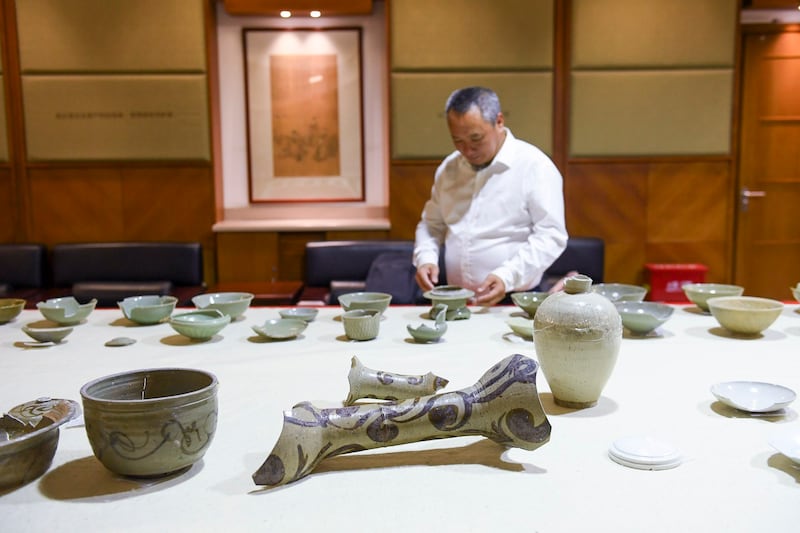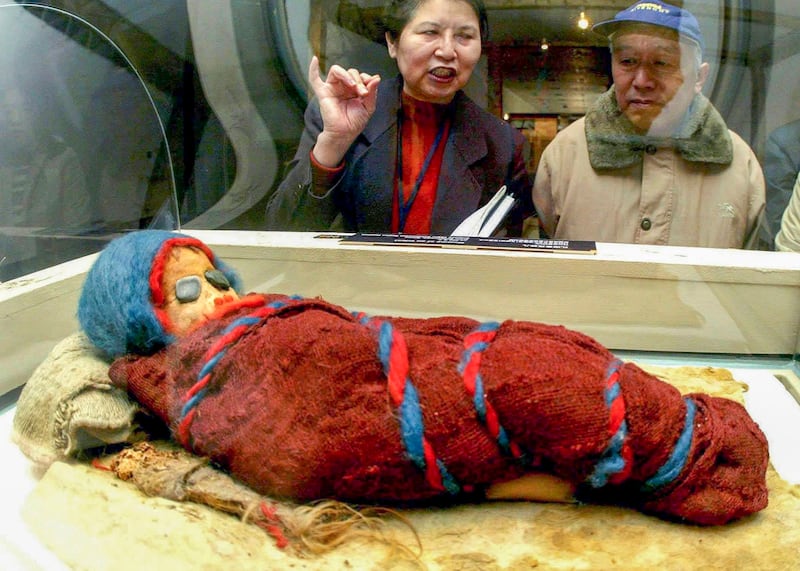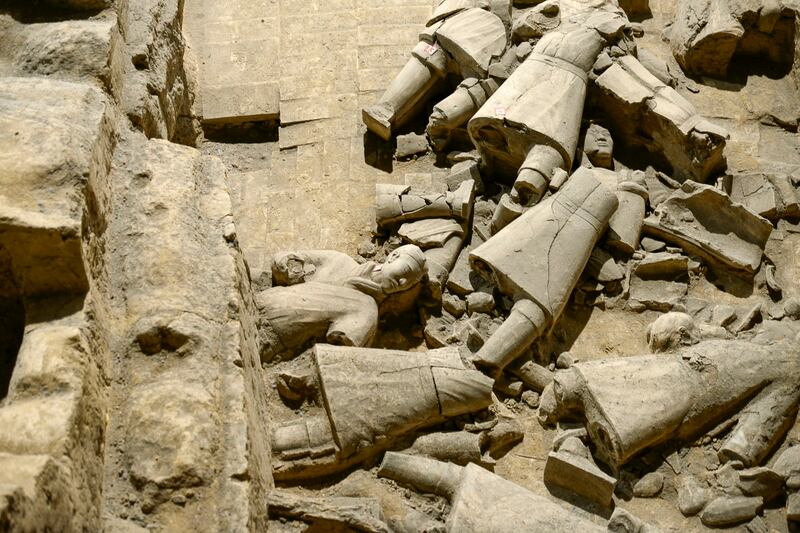China is working on major archaeological projects with its neighbors in Central Asia in a bid to dig up fresh finds to shore up its official historical narrative and extend its regional soft power, experts told RFA Mandarin in recent interviews.
Since President Xi Jinping launched his "Belt and Road" global influence and supply chain initiative in 2013, the country has invested heavily in high-profile excavations along the ancient Silk Road trading routes that once linked China to the Middle East via Central Asia.
The Chinese Communist Party relies on strongly stated historical narratives to boost China's image at home and abroad, and Xi believes archaeology can help with that, experts said.
Last month, Chinese historians and archaeologists claimed that a 7th century Chinese empress ordered the construction of an ancient Buddhist temple in Xinjiang, home to 11 million mostly Muslim Uyghurs, emphasizing the idea of the region as a "melting pot" going back centuries.
Yet the whole idea of the Silk Road was invented in the 19th century as a colorful metaphor to describe ancient patterns of trade and communication between China, Central Asia, the Middle East and Europe, according to Sören Stark of the Center for the Study of the Ancient World at New York University.
Related stories
[ Ancient Buddhist temple in Xinjiang stirs controversyOpens in new window ]
[ Chinese research in Xinjiang mummies seen as promoting revisionist historyOpens in new window ]
"The whole notion of the Silk Road is ... a construct, right, in which we are operating," he told RFA Mandarin in an interview earlier this month. "There wasn't such a thing like the Silk Road -- there never was. It's a 19th century construct."
"There were corridors, there was a network of communication between China, Rome, India, the Near East, northeastern Europe, the Tigris," he said.
"It's just a little bit heightened right now because there's obviously a lot of government funding from the Chinese side into the sphere of Central Asian archaeology."
70 digs
China has carried out more than 70 archaeological collaborations in Central Asian countries in a bid to "study the ancient Silk Road exchanges between China and Central Asia," the nationalistic Global Times newspaper reported in June.
One joint dig in Uzbekistan recently unearthed an ancient settlement dating back to the 8th century BC near the Surkhandarya river.

"Chinese and Uzbek experts have made a total of three discoveries in the Central Asian country from April to June," the paper reported on June 23, citing an investigation into the ancient Kushan Empire, along with ruins and cliff paintings in the Fergana valley.
The projects are being touted as part of the Belt and Road initiative, with the paper quoting cultural scholar Fang Gang as saying that "the story of the ancient Silk Road is transforming into today's Belt and Road Initiative to strengthen the ties between China and Central Asian countries."
The point, according to archeologist Wang Jianxin at Xi'an's Northwest University, is to "challenge Western-centered interpretations of ancient Silk Road culture while also enhancing the world's understanding of China's contribution to ancient Silk Road civilization," the paper said.
But archaeologists said nationalistic agendas and archaeology make uneasy bedfellows, although China isn't the only country to look to the past to boost its legitimacy in the present.
"My concern is that as with any country or any government that supports archaeological excavations (in contrast to excavations supported by academic institutions or private funds) that there is a nationalistic agenda," Silk Road scholar Judith Lerner told RFA Mandarin in a written reply.
The aim is often "to prove that we were there first, that people speaking a particular language can be traced by that language back to the country supporting the excavations, that is, China," she said.
‘Add Chinese voices’
For example, the idea of China as a historically peaceful influence in the region has been widely propagated by Northwest University's Wang Jianxin, who has used findings from the Uzbekistan digs around the Kushan Empire and Yuezhi sites as evidence that the two peoples lived peacefully side by side near the Surkhandarya river.
Wang has said his mission is to "add Chinese voices" to the archaeological work currently being done in Central Asia.
"We just really don't know," Lerner said. "And I think we really have to look at things more culturally and sociologically."
Stark said Chinese teams typically look for evidence from the point of view of the official history of China, to see if it supports it or disproves it.
"Essentially they come equipped with their national ... Chinese-language, historical sources and what they tell about the history, what they tell about the history of the Western regions," Stark told RFA Mandarin in an interview earlier this month. "That's their guide in what they are doing ... they always come from a Chinese perspective on things."

"They're not fundamentally questioning actually whether this whole narrative in these sources is problematic," he said.
For example, the people known in China as the Yuezhi who allegedly lived in harmony with the proto-Chinese Kunshan Empire may not have been called that when they were alive, Stark said, adding that they could have been a tribe of Central Asian nomads, giving them more links to the Turkic peoples of Xinjiang than to modern Han Chinese.
"The tombs that the Chinese team has excavated are very consistent with the burial traditions of nomadic groups in Central Asia, and not just in Bactria [an ancient kingdom spanning parts of Afghanistan, Uzbekistan, and Tajikistan] ... but also in southwestern Central Asia and Xinjiang," Stark said.
It is precisely links and conclusions like those about the "Yuezhi" that can be used to shore up a nationalistic and ultimately colonialist agenda, according to critics of China's forays into regional archaeology.
"They are not taking into account what has been done before. They come as if there was a plain slate," Stark said, adding there are plenty of similarities between the colonial attitudes of the Western expeditions that poured into the region following the collapse of the Soviet Union and those of Chinese archaeology under Xi Jinping.
"This is a very colonial approach I think in both ways," Stark said. "And that is the problem I have with it, this idea that people from the outside have come to teach or discover things that were not discovered before."
Much of the previous archeological work in the region was published in Russian, which some Chinese experts don't seem to have read, he said.
Countering ‘untrue narratives’
Meanwhile, Beijing is pouring money into the field on a large scale to counter "untrue narratives" about the northwestern region of Xinjiang, according to comments from Chinese Communist Party United Front Work Department deputy director Pan Yue on June 12.
"There is an untrue narrative in the international community that separates Xinjiang culture from Chinese culture and even sets it up in opposition," Pan said. "But a large amount of archaeological evidence tells us that Xinjiang has been an important part of the Chinese cultural circle since ancient times."

His comments are straight out of Beijing's propaganda playbook on "self-confidence" and "exploring the origins of Chinese civilization," with Xi claiming in May 2022 that cultural relics and cultural heritage "carry the genes and blood of the Chinese nation," describing them as its "inexhaustible resource."
In July, the State Administration of Chinese Cultural Heritage said it would focus on cultural relics as a matter of national priority under the current five-year plan.
But using material findings dug up from burial sites to prop up theories about ethnic groups and their historical interactions is highly problematic in the absence of written clues, Stark said, adding that questions of ethnicity aren't generally very productive for archaeologists.
"Today, in the 21st century, we think everybody has and always had an ethnic identity, but that's just not the case," he said. "It's a very modern phenomenon that in the premodern past was mostly tied up with the elites."
"The Chinese teams excavating in Central Asia are very much obsessed about this kind of ethnic identity, [with] finding the tribes that are mentioned in the Chinese texts," Stark said.
"[But] archaeology is not very well equipped to answer that with precision and certainty."
Translated by Luisetta Mudie. Edited by Malcolm Foster.
